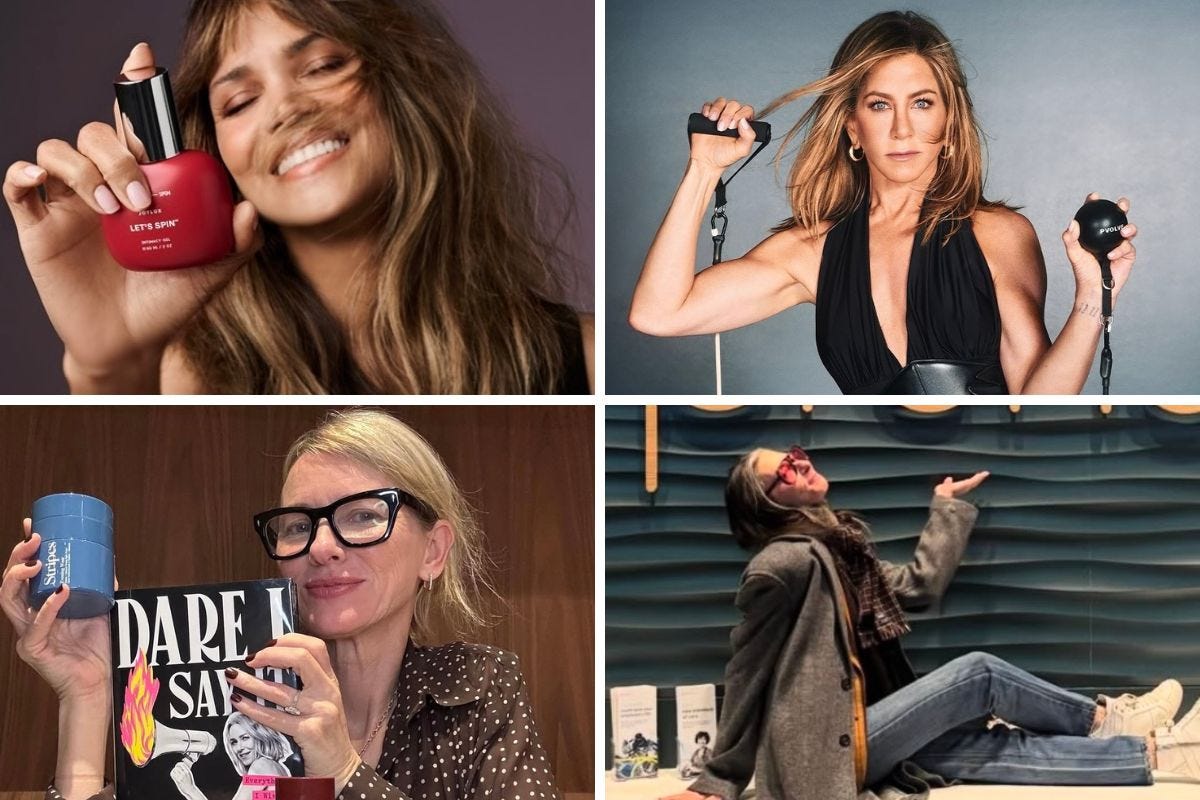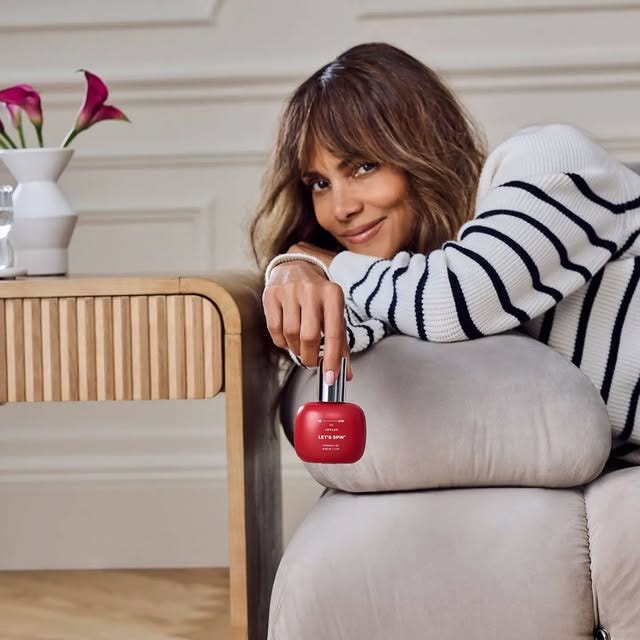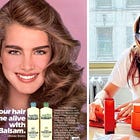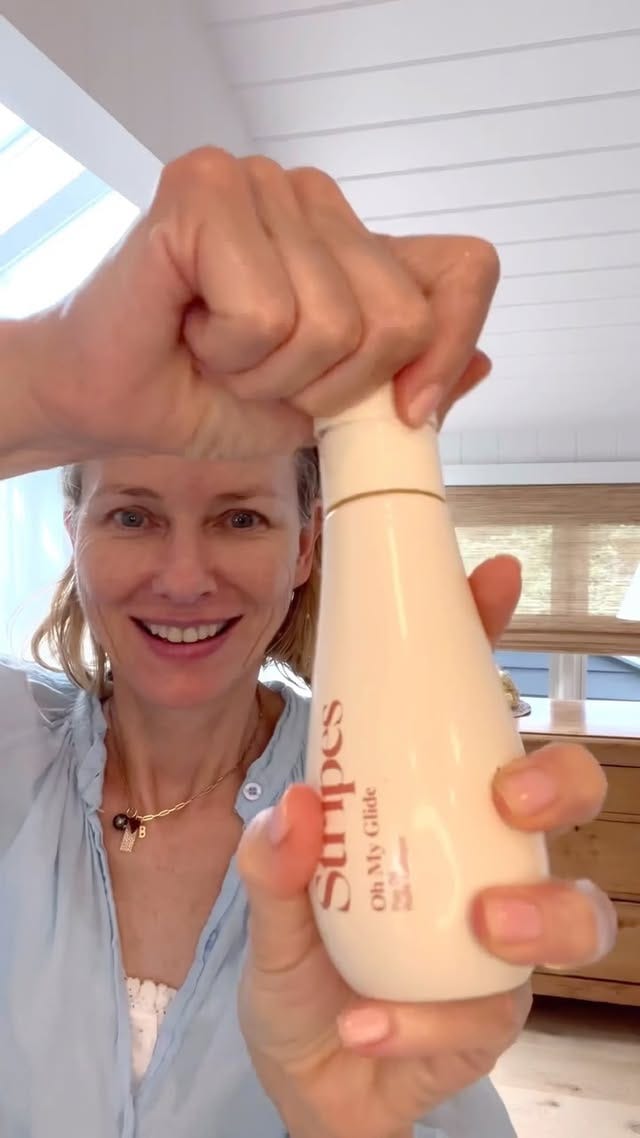Hey WNVM-ers,
Menopause is getting a lot of attention now, which is good. But according to AARP, only about 20% of OB-GYNs get any sort of menopause education. It’s led to a lot of confusion, which provides an opening for someone to try to sell you something. There are even menopause influencers now.
I (hi, it’s Cheryl) report on many totally random things that interest me here at WNVM, like retro soda cans and Slayer selling coolers. But for years my bread and butter was covering the beauty and wellness industries, specifically the business side, for outlets like “Business of Fashion,” FT, and “Vogue Business.” Through this lens, I take a hard look this week at how some Gen X celebrities are using the standard beauty playbook to sell questionable stuff for perimenopause and beyond, capitalizing on an information and resource void.
Plus, we rank the Gen X Super Bowl ads, a rude message for Prince HAIR-y, and the AARP’s awards get it right.
I’ve Got the Brains, You’ve Got the Looks — Let’s Make Lots of Money
Gen X celebs are selling menopause health and wellness products — from ‘down-there skin care’ to exercise modalities — like they’re fancy beauty products.
By Cheryl

Recently, Instagram fed me an ad featuring Halle Berry in a hot pink bandana talking about how she’d just launched her new “360 degree female longevity brand.” She then mentioned her diagnosis of perimenopause and “BLEEP atrophy.” Some entity, presumably Meta (whose CEO famously wants more “masculine energy”), bleeped out the word “vaginal.”
To me, this is the perfect summation of where we are in the world of menopause capitalism. We are supposedly excited to lift the stigma on menopause, cheekily calling it “the Pause” and shouting out our “menoposses.” But we can’t even say “VAGINA” out loud on parts of the internet? This is the vacuum into which everyone can toss their products that promise to fix you.
A lot of outlets have covered the growing menopause market for telehealth services, beauty products, supplements, and beyond. It’s currently worth about $18 billion and could reach $27 billion by 2030, according to Axios. In December, Jessica Bennett at The Cut wrote a comprehensive piece about the “perimenopause gold rush” and all the celebs cashing in on it, which I highly recommend reading.
I’m going to dig a bit deeper into some specific products/services that Berry, Jennifer Aniston, Naomi Watts, and Stacy London shill. I reached out to one OB-GYN for this but they were on some deadlines and responded with, “I don't have time to look at another worthless celebrity product.” So that tells you where at least a faction of the medical establishment is with all this.
Meno-care has a lot of parallels to the beauty industry — it’s an area without a lot of solid scientific information, geared towards women’s insecurities and anxiety as their bodies change with age. Not surprisingly, companies are selling products using well-worn beauty founder tropes, vague clinical studies for PR, and popular technology and ingredients that are buzzy in beauty at the moment.
Let’s start with Berry’s BLEEP.
Beautiful Lube
Berry, 58, has been a vocal advocate for more menopause education. She hosts a Masterclass called “The Magic (Ed. note: bahaha) of Menopause,” featuring well-known OB-GYNs like Jen Gunter. And she re-launched her site, Re-spin, formerly focused on fitness and nutrition, as the aforementioned “female longevity brand.”
The new site went live February 18, offering monthly subscriptions ($18/month for information and community access and $100+/month for a “care plan” and a health coach, three month minimum required). The brand is already doing product collaborations with Joylux, a femtech brand that bills itself “the global leader in intimate wellness.” Turns out Berry is an investor in Joylux. (For any beauty geeks out there, so is Dr. Kathy Fields, the founder of Proactiv and former MLM skin care brand Rodan + Fields.)
The Joylux collab features the $45 Let’s Spin Intimacy Gel, which is a lube. Berry said, “When I realized that the product I needed wasn’t on the market, I decided to make it myself.” This is a very tired beauty founder trope (here and here, as examples) that is now a joke among beauty writers. It’s hard to launch anything truly innovative in a crowded beauty market these days, but founders keep trying to convince us that they are.
There are a lot of lubes, too, but there probably is room to make nicer ones. Berry just doesn’t really explain how hers is different or better.
Green Light for Red Lights
Then there is the Joylux $495 vFit Plus Red Light Intimate Wellness Device “for pelvic floor health and wellness,” using red lights, “gentle heat,” and “sonic vibrations.” This is allegedly a health-focused product, but you can buy it at Nordstrom, Bloomingdale’s, Neiman Marcus, Ulta, and Goop, all purveyors of expensive beauty products. Sexual health products have been slowly creeping into beauty assortments for years.
The vFit device itself promises nothing concrete (“promote vaginal wellness, improve sensation, and increase confidence”), because it legally can’t. It’s listed as a Low Risk General Wellness Device by the FDA, meaning it can’t claim to cure anything. (Joylux sells a product called the vSculpt in Canada that is classified differently and explicitly says it can strengthen the pelvic floor, improving bladder control. The company confirmed to me in an email that they are the same device.)
Red light is one of the buzziest and most expensive technologies in facial skin care right now, usually in the form of masks or wands. Berry explicitly acknowledges the beauty connection in Oprah Daily: “The [vFit] innovation takes the same red-light technology you can use on your face…”
The jury is still out about how effective the treatment is at stimulating collagen, but at-home versions will probably only give you mild improvement around the margins, if any at all. It’s beyond the scope of this article to dig into the clinical efficacy of vFit’s technology for “vaginal wellness,” but wow, I really want to write more about this. I give big side-eye to the home facial versions, so color me skeptical about the vaginal one.
Hyaluronic Acid? There?
Naomi Watts, 56, is no stranger to the inner workings of the beauty industry. She founded ONDA beauty, a so-called clean beauty retailer in 2014. Stripes, her menopause beauty brand, features a few intimacy products. Let’s talk about Vag of Honor, a $50 “intimate hydrating treatment.” (It’s also a chapter title in her new menopause book. Synergy!)
The brand copy notes that it contains hyaluronic acid, an ingredient that has been buzzy in the beauty industry for a long time now. (Berry’s lube also touts hyaluronic acid.) For years, Eva Longoria has been teaching people via L’Oréal commercials how to pronounce the word.
While the word “acid” sounds burn-y, it’s a humectant meant to increase moisture. There is a lot of discourse about how good it actually is at doing this. Molecular size and quantity in the formulation matter, but as a consumer, it’s impossible to really know. It appears in inexpensive drugstore products and expensive luxury creams alike.
Here’s where I’d like to put on my former nurse cap and complain about imprecise body part naming, though. It took me a while to figure out what this product is actually for. It’s not a lube (Stripes has one of those), or meant for internal vaginal dryness. If you click through to the “how to use” tab, you are told to “massage onto external intimate areas.” So this is not actually for the vagina (the internal canal); it’s meant for the labia (the outer lips). In Stripes’ defense, this is a legitimate product need for some women.
I tried to come up with some names using “vulva” that could make the product’s use clearer: Vulvacious. ThankVul. Vul of Moisture. Vul-uronic Acid. OK, fine. I understand why the brand wanted to stick with Vag of Honor. As product names go, it’s cringey and inaccurate, but as puns go, it’s decent.
‘Clinically Proven’ Menopause Exercise
“Jennifer Aniston’s Fitness Routine ‘Beats’ Official Menopause Advice, Study Finds,” reads a recent headline in Women’s Health. Since 2023, Aniston, 56, has been a paid ambassador for Pvolve, a “functional fitness brand” that is in the Pilates/barre family of workouts. It uses bands, light weights, sliders, and a ball. Similar headlines appeared on People, Healthline, Good Housekeeping, and the Independent.
The study, performed at the University of Exeter, looked at 72 women in pre-, peri-, and post-menopause, all not taking hormone replacement therapy. It divided them into two groups, having one do their usual exercise and the second do Pvolve for 12 weeks.
While there were some minor increases in hip strength, balance, flexibility, and lean mass, the authors’ big takeaway was “this would suggest that the menopause transition, and associated decline in sex hormone production, may not affect the ability to adapt to a resistance exercise training program.” So this means menopausal people may see results from exercise. Groundbreaking.
This study has several limitations. First, one of the authors, Dr. Nima Almadari, is a paid member of Pvolve’s board. That’s always a red flag. And the study never noted which “usual exercise” the control group was performing, so what are they comparing Pvolve to? If the control group was not doing any sort of resistance training or mobility work, then obviously they wouldn’t see change in those areas. Finally, it featured a very small number of participants.
But it gave the brand a lot of great headlines! This is a common PR tactic in beauty. Having studies to “prove” something “works” is more important than ever for consumers. “Beauty brands are leaning much harder into clinical and professional validation to drive differentiation when marketing to the consumer,” the COO of a testing organization told Beauty Matter.
This isn’t that common for name-brand exercise modalities, at least that I can tell, but now a lot more menopausal people surely know the name of Aniston’s “favorite” workout.
Radical (Radiological) Self-Care
Stacy London, 55, the former stylist on the long-running show “What Not To Wear,” has been a menoposse member for years. She had a menopausal beauty brand called State Of, since shuttered. She now has a fashion brand at QVC and hosts a menopause podcast.
London has done at least one #partner promotion for Prenuvo, the startup that offers full-body screening MRI exams and which Kim Kardashian and other influencers have touted. Cindy Crawford and husband Rande Gerber are investors. It is not covered by insurance and can cost between $1000 and $2500.
In a recent Instagram post, London poses in front of a Prenuvo sign. She wrote, “...It wasn’t until peri-menopause that I realized you really can’t look your best if you don’t feel your best….” Pvolve has also partnered with Prenuvo. Wile Women, a perimenopausal supplement brand co-founded by Judy Greer, chimed in on London’s post to write, “We’re HUGE fans of Prenuvo!...”
During the early days of the pandemic, beauty rituals became associated with self-care, and Prenuvo is using similar language and seems to be courting the menopause population. I find this one particularly dystopian, because people who are under- or uninsured and have concerning symptoms often can’t afford to get an MRI — never mind one that insurance doesn’t cover that you’re seeking for peace of mind.
A friend who is a radiologist told me that the technology is fine and can sometimes detect early disease, but that the risk is for false positives, resulting in biopsies or treatments that might not be necessary. He has worked with one of Prenuvo’s competitors and told me the only difference between it and a regular MRI is that the clients are given “fancier robes to wear.” It’s shocking to me that our healthcare system offers this, but can’t properly take care of people who really need it, at a reasonable cost.
I’m so BLEEPING exhausted.
Story updated February 22 to reflect the launch of Re-spin.
We are two Gen X journalists who celebrate people of our generation doing cool things, as well as analyze all the '80s and '90s nostalgia in current pop culture, fashion, and beauty. Read more stories like this one here!
You Oughta Know
A ranking of six Gen X-adjacent Super Bowl ads, from cutest to most disturbing: 1) Nike girl’s flag football, set in a 1985 high school. The soundtrack! 2) “Seinfeld”-coded Jason Alexander Mike’s commercials where he plays every character. 3) Drew Barrymore and Orlando Bloom for MSC Cruises, featuring Madonna’s “Holiday” and a Dirty Dancing reference. 4) That “When Hellmann’s Met Sally” embarrassing-ass commercial. 5) The Jesus/He Gets Us (what even is this org?) commercial featuring Johnny Cash’s version of Depeche Mode’s “Personal Jesus.” How?! 6) Oh my god, Seal-as-a-seal.-CW
I cannot wait to read/listen to the new book by journalist Tanya Pearson, Pretend We’re Dead: The Rise, Fall, and Resurrection of Women in Rock in the ‘90s. It promises interviews with Liz Phair, Shirley Manson, members of Veruca Salt, Hole, and more. (h/t to Lesa Hannah at Starving for Beauty for the tip.) -CW [Bookshop]
In a packed week of awards ceremonies, Alan Cumming hosted the AARP Movies For Grownups Awards, which corrected some major oversights this season, like recognizing Joan Chen Best Supporting Actress for Dídi and Sing Sing’s Colman Domingo, Clarence Maclin, and Paul Raci for Best Ensemble. Best Actress winner Demi Moore also continued her red carpet streak. [AARP.org]
Sam McKnight, former hairdresser to Princess Diana, posted an Instagram worth reading in full. In it, he exhorts the balding Prince Harry to trim his hair short or possibly even consider a hair transplant. “...Just like myself, the lush hedging is no more, a mere wisp or two of its former self…” I suspect he may end up deleting this one.-CW. I guess we know whose side he’s on in this Harry v. Wills feud. -FSH, Team Meghan [Instagram]
Marc “On-the-Cusp Gen-X/Boomer” Maron highlights the former with his past two pods featuring Oscar-winning Love Hurts leading man Ke Huy Quan and Oscar nominee Demi Moore. The interviews are particularly inspiring about finding self-acceptance and success of your dreams later in life, and for their sheer positivity, optimism, and nostalgic name-drops. Maron, who’s co-starring in the upcoming Bruce Springsteen biopic, also gives a particularly rousing call to get out of our bubbles and off our asses and go save democracy from the community level. – FSH [WTF With Marc Maron]
Gen X isn’t the only cohort excited for the Valentine’s Day premiere of Bridget Jones: Mad About the Boy on Peacock. (Also, teaser for next week’s issue!) Apparently, Zoomers romanticize the social media-free ‘90s days of yore as a “simpler time,” while not registering the era’s gross misogyny and all that. They’re also making up about half the audience at author Helen Fielding’s book signings, so the upside there is that Gen Z can read books. –FSH [The Guardian]











Also, just wanted to say. There is Quebec star (The Quebec Oprah) who made a documentary on perimenopause because she could not believe her symptoms. Well she does not sell anything for it. But did go to the goverment and use her power to get the bio hormone replacement to be free for women.
What a diffrence from Hollywood stars.
Halle has been everywhere.
I am glad people are finally talking about it. However I also feel another way to make women spend their money and feel bad. Thanks for writing this.